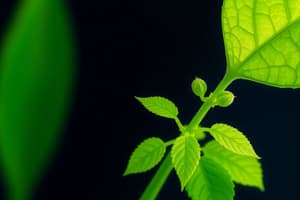Podcast
Questions and Answers
What is the role of Rubisco in the Calvin Cycle?
What is the role of Rubisco in the Calvin Cycle?
Rubisco binds carbon dioxide (CO2) to ribulose bisphosphate (RuBP), initiating carbon fixation.
How many molecules of 3-phosphoglycerate (3-PGA) are produced from three CO2 in the Calvin Cycle?
How many molecules of 3-phosphoglycerate (3-PGA) are produced from three CO2 in the Calvin Cycle?
A total of six 3-PGA molecules are produced from three CO2 and three RuBP.
What is produced from the activation and reduction of 3-PGA?
What is produced from the activation and reduction of 3-PGA?
The activation and reduction of 3-PGA produce six molecules of glyceraldehyde-3-phosphate (G3P).
Explain the significance of the regeneration of RuBP in the Calvin Cycle.
Explain the significance of the regeneration of RuBP in the Calvin Cycle.
What is the energy investment required for the regeneration of RuBP?
What is the energy investment required for the regeneration of RuBP?
Describe the overall glucose production from the Calvin Cycle in terms of cycles required.
Describe the overall glucose production from the Calvin Cycle in terms of cycles required.
What are some limitations of Rubisco in the light-independent reactions?
What are some limitations of Rubisco in the light-independent reactions?
What is the total energy input needed for the Calvin Cycle to produce one glucose molecule?
What is the total energy input needed for the Calvin Cycle to produce one glucose molecule?
Flashcards are hidden until you start studying
Study Notes
Light Independent Reactions (Calvin Cycle)
- Takes place primarily in the stroma of chloroplasts.
- Requires carbon dioxide (CO2); three CO2 molecules initiate the process.
- Carbon fixation: CO2 binds to ribulose bisphosphate (RuBP) using the enzyme Rubisco, forming an unstable six-carbon compound.
- The six-carbon compound immediately breaks down into two molecules of 3-phosphoglycerate (3-PGA).
- Total of six 3-PGA molecules are produced from three CO2 and three RuBP.
Activation and Reduction
- The second step requires six ATP and six NADPH molecules.
- Each 3-PGA molecule reacts with ATP to become activated, gaining energy.
- Activated 3-PGA molecules then react with NADPH to produce glyceraldehyde-3-phosphate (G3P), an essential building block for glucose.
- Total production after this step is six G3P molecules from six activated 3-PGA.
Regeneration of RuBP
- A majority of produced G3P are used to regenerate RuBP for the cycle to continue.
- This step requires five G3P and three additional ATP molecules.
- Conversion results in the production of one usable G3P for every cycle, leading to the conclusion that only half a glucose molecule is formed per cycle.
- Full glucose synthesis requires two cycles, needing six CO2 and a total of 18 ATP.
Efficiency and Summary
- Rubisco is not highly efficient and can bind to oxygen, generating toxic byproducts.
- The entire cycle is essential for producing glucose, which is crucial for plant energy storage and metabolism.
- Overall, multiple cycles and significant energy investment (ATP and NADPH) are needed for glucose production through photosynthesis.
Light Independent Reactions (Calvin Cycle)
- Occurs in the stroma of chloroplasts, where photosynthesis takes place.
- Initiated by three molecules of carbon dioxide (CO2).
- CO2 undergoes carbon fixation by binding to ribulose bisphosphate (RuBP) via the enzyme Rubisco, forming a transient six-carbon compound.
- This unstable compound quickly splits into two molecules of 3-phosphoglycerate (3-PGA).
- The process results in the production of six 3-PGA molecules from three CO2 and three RuBP.
Activation and Reduction
- The activation phase consumes six ATP and six NADPH molecules.
- Each 3-PGA molecule is converted into an activated form through ATP, gaining energy necessary for the next reaction.
- Activated 3-PGA interacts with NADPH to yield glyceraldehyde-3-phosphate (G3P), a key component for synthesizing glucose.
- A total of six G3P molecules are generated from six activated 3-PGA.
Regeneration of RuBP
- A majority of the produced G3P is utilized to regenerate RuBP, enabling the cycle to repeat.
- This regeneration process uses five G3P and three ATP molecules.
- For each cycle, one usable G3P is produced, indicating that only half a glucose molecule is synthesized per cycle.
- Completing the synthesis of one glucose molecule requires two Calvin cycles, necessitating six CO2 and a total of 18 ATP.
Efficiency and Summary
- Rubisco, while essential, has low efficiency and can incorrectly bind oxygen, leading to harmful byproducts.
- The Calvin cycle is pivotal for glucose production, a crucial resource for plant energy storage and metabolic processes.
- Multi-cycle engagement and substantial energy investment in ATP and NADPH are required for successful glucose synthesis during photosynthesis.
Studying That Suits You
Use AI to generate personalized quizzes and flashcards to suit your learning preferences.




